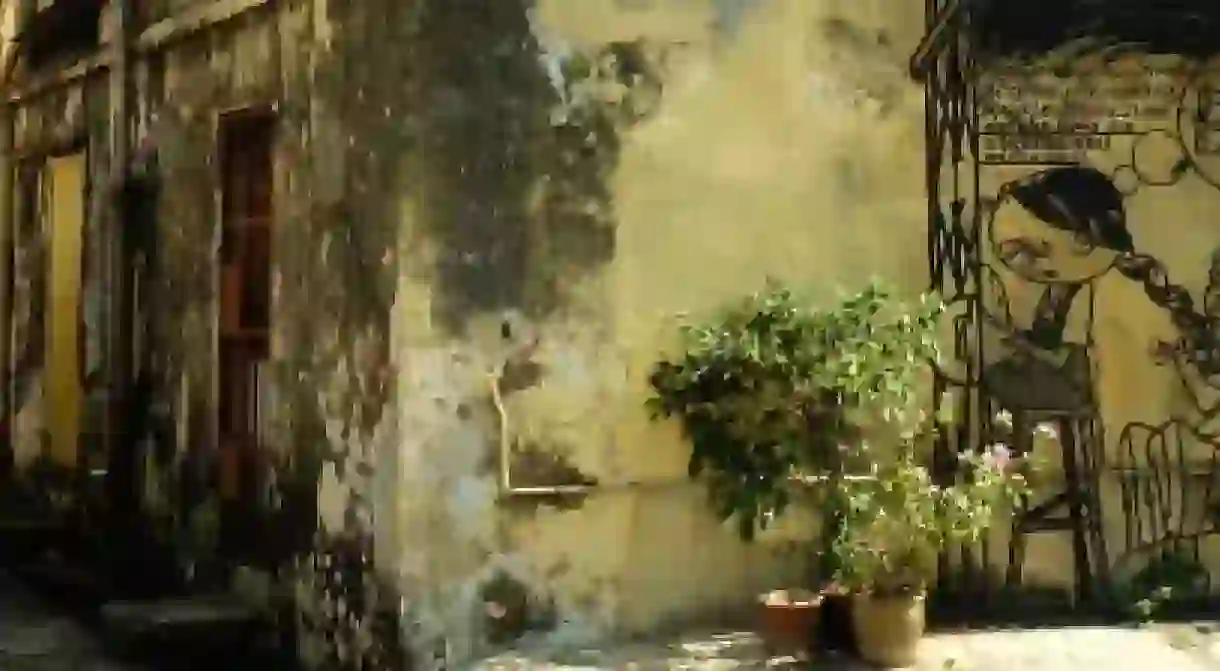Iron Caricatures: Penang's New Street Art

Penang is famous for its street food and colonial history, but in the past six years, it has also nurtured a flourishing art scene. The Malaysian sculpture studio SCULPTUREATWORK is leading the new wave of creative urban landscaping across Georgetown, the island’s capital, creating a spectacular modern heritage for this historic corner of Malaysia. We find out more about their fascinating sculptures.

When walking around Georgetown late at night, you may well stumble upon three Japanese spies and a pouting geisha, hiding in the shadows of an alleyway. Not real spies, of course, but the characters of a small landmark from Georgetown’s street art scene. From a distance, they look like nothing more than drawings on the wall. Up a little closer, the play of light and shadows brings out their three-dimensionality – the spies are caricatures sculpted from wrought iron, mounted on an otherwise inconspicuous wall.
Why are they there? A caption in cursive wrought iron handwriting explains, “In the early 20th century the slightly risqué reputation of this area was further enhanced by the presence of Japanese camera shops, which were suspected of covert spying activities.”

This tidbit of historical information is part of a wider street art exhibition entitled Marking George Town, commissioned by the Penang State Government in 2009 as a physical way of marking Georgetown’s then recent status as a UNESCO World Heritage Site.
An international competition was held to find an artistic proposal, and the Malaysian sculpture studio SCULPTUREATWORK won the contract with its idea of ‘voices from the people’ represented through wrought iron caricatures. Their construction took several years, resulting in a current total of 52 sculptures across the tangled network of Georgetown’s streets.

SCULPTUREATWORK is a creative studio based at Bangsar (a suburb of Kuala Lumpur) with a workshop in Georgetown. It has grown from its 1992 architectural and urban planning roots to incorporate more than a hundred sculptors, designers and artists, to meet ‘the growing demand for sculptures in public spaces’ and provide the space and funding for “research and collaboration for artists and other creative practitioners.” The growth of the company has been connected to the growth of Penang’s state efforts to develop the cultural and artistic heritage of the island.

Penang’s street art renaissance has primarily been motivated by the pragmatic desire of attracting tourists – the state tourism bureau proclaims its pursuit of ‘world tourism’ on its logo and seems to be well-funded in its projects and publicity efforts.
Nevertheless, the aesthetic and cultural impact on Penang’s local culture has been profound. The caricatures’ locations, designs and often wry commentaries on local and tourist culture conspire to make the caricatures an increasingly natural part of the urban landscape.

The best way to see this is to wander around the streets of Georgetown and look out for the wrought iron caricatures. Upon arrival in Penang airport, you can pick up a free map with the descriptions and locations of all 52 caricatures (although this rather takes out the spontaneity and fun of finding them for yourself).

Some caricatures are somewhat over-optimistic attempts at marketing the city. A cheeky robber draws pedestrians’ attention to the claim that “Campbell Street is Penang’s Fifth Avenue, a retail paradise where shoppers can stroll along the row of shophouses and feast their eyes on an array of goods.”
Some offer frank and amusing commentaries on the encounter between tourist and traditional cultures. In Kopi ‘O, a scene mounted above a corner shop, a bespectacled hipster tourist requests a ‘one double shot decaf espresso’. Perhaps in a gentle dig at tourists who prefer Starbucks to street stalls, the caricature shows the hipster about to receive a plain old ‘kopi ‘o’, the traditional Malaysian coffee roasted with sugar and butter.
Other caricatures are entertaining and offer explanations of street names. On Rope Walk, a young girl sits having her hair braided, a long-suffering expression on her face and thoughts of rope tying cartoonishly bubbling out of her head. The explanation is this: “Rope walk was named after the rope-making activities on the street.”
Likewise, Love Lane is explained through local gossip: “The local Chinese say the rich men who lived on Muntri Street kept their mistresses here, hence the name Ai Cheng Hang or ‘Love Lane.'” A cheating husband climbs up a cleverly positioned bar to a window in the house, rushing to answer his wife’s call.

The whimsical sense of humor evident in the iron caricatures is a hallmark of SCULPTUREATWORK’s projects. In 2010, the studio debuted their wrought iron sculpting skills and irreverent approach to art at Archidex (International Architecture, Interior Design and Building Exhibition) with their offering of a “Totally Meaningless Exhibition.”
It is telling that the studio would “rather have [their work] in a porch gallery or in a hip factory” than at a serious, international display, and that its artists proclaim this preference loudly. It is this sense of heart in the studio’s work that elevates the caricatures in Marking George Town beyond the tourist-attracting motives of its state funding.
Besides the iron caricatures, SCULPTUREATWORK has created many other pieces of street art and sculptures around Penang. Most notable are the cubist, metal dancers in Little India, the direction-indicating sculptures in Times Square, and the most recent Give Me Five sculpture, constructed from calcium carbonate and powder-coated steel, which celebrates Penang’s annual ‘Campaign for a Lane’ cycling event.

Penang’s street art scene is developing beyond the famous Ernest Zacharevic murals, which are still featured on the T-shirts and postcards in all the tourist shops but which are fast fading on the famed walls themselves.
SCULPTUREATWORK’s contributions have been a successful combination of artistry and humor, creating a unique urban landscape and street art heritage for modern Penang.













